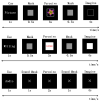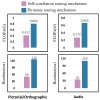A Spatio-Temporal Capsule Neural Network with Self-Correlation Routing for EEG Decoding of Semantic Concepts of Imagination and Perception Tasks
- PMID: 39338733
- PMCID: PMC11436183
- DOI: 10.3390/s24185988
A Spatio-Temporal Capsule Neural Network with Self-Correlation Routing for EEG Decoding of Semantic Concepts of Imagination and Perception Tasks
Abstract
Decoding semantic concepts for imagination and perception tasks (SCIP) is important for rehabilitation medicine as well as cognitive neuroscience. Electroencephalogram (EEG) is commonly used in the relevant fields, because it is a low-cost noninvasive technique with high temporal resolution. However, as EEG signals contain a high noise level resulting in a low signal-to-noise ratio, it makes decoding EEG-based semantic concepts for imagination and perception tasks (SCIP-EEG) challenging. Currently, neural network algorithms such as CNN, RNN, and LSTM have almost reached their limits in EEG signal decoding due to their own short-comings. The emergence of transformer methods has improved the classification performance of neural networks for EEG signals. However, the transformer model has a large parameter set and high complexity, which is not conducive to the application of BCI. EEG signals have high spatial correlation. The relationship between signals from different electrodes is more complex. Capsule neural networks can effectively model the spatial relationship between electrodes through vector representation and a dynamic routing mechanism. Therefore, it achieves more accurate feature extraction and classification. This paper proposes a spatio-temporal capsule network with a self-correlation routing mechaninsm for the classification of semantic conceptual EEG signals. By improving the feature extraction and routing mechanism, the model is able to more effectively capture the highly variable spatio-temporal features from EEG signals and establish connections between capsules, thereby enhancing classification accuracy and model efficiency. The performance of the proposed model was validated using the publicly accessible semantic concept dataset for imagined and perceived tasks from Bath University. Our model achieved average accuracies of 94.9%, 93.3%, and 78.4% in the three sensory modalities (pictorial, orthographic, and audio), respectively. The overall average accuracy across the three sensory modalities is 88.9%. Compared to existing advanced algorithms, the proposed model achieved state-of-the-art performance, significantly improving classification accuracy. Additionally, the proposed model is more stable and efficient, making it a better decoding solution for SCIP-EEG decoding.
Keywords: EEG decoding; brain-computer interface (BCI); capsule neural network; self-correlation routing; semantic concepts.
Conflict of interest statement
The authors declare no conflicts of interest.
Figures











Similar articles
-
ConTraNet: A hybrid network for improving the classification of EEG and EMG signals with limited training data.Comput Biol Med. 2024 Jan;168:107649. doi: 10.1016/j.compbiomed.2023.107649. Epub 2023 Nov 2. Comput Biol Med. 2024. PMID: 37980798
-
EEG-based BCI Dataset of Semantic Concepts for Imagination and Perception Tasks.Sci Data. 2023 Jun 15;10(1):386. doi: 10.1038/s41597-023-02287-9. Sci Data. 2023. PMID: 37322034 Free PMC article.
-
Attention-Based DSC-ConvLSTM for Multiclass Motor Imagery Classification.Comput Intell Neurosci. 2022 May 5;2022:8187009. doi: 10.1155/2022/8187009. eCollection 2022. Comput Intell Neurosci. 2022. PMID: 35571721 Free PMC article.
-
[A review on electroencephalogram based channel selection].Sheng Wu Yi Xue Gong Cheng Xue Za Zhi. 2024 Apr 25;41(2):398-405. doi: 10.7507/1001-5515.202308034. Sheng Wu Yi Xue Gong Cheng Xue Za Zhi. 2024. PMID: 38686423 Free PMC article. Review. Chinese.
-
Parkinson's disease detection and classification using EEG based on deep CNN-LSTM model.Biotechnol Genet Eng Rev. 2024 Nov;40(3):2577-2596. doi: 10.1080/02648725.2023.2200333. Epub 2023 Apr 11. Biotechnol Genet Eng Rev. 2024. PMID: 37039259 Review.
References
-
- Mandal S.K., Naskar M.N.B. MI brain-computer interfaces: A concise overview. Biomed. Signal Process. Control. 2023;86:105293. doi: 10.1016/j.bspc.2023.105293. - DOI
-
- Dattola S., La Foresta F. Effect of Rehabilitation on Brain Functional Connectivity in a Stroke Patient Affected by Conduction Aphasia. Appl. Sci. 2022;12:5591. doi: 10.3390/app12125991. - DOI
MeSH terms
Grants and funding
- No.81705/Shengzhi Du
- Grant No.NCRCOP20230013/Yinghui Chang
- No. 2021ZD011/Jigang Tong
- No. 62303244/Wenyu Li
- No. 22JCQNJC01440/Wenyu Li
- 111-2221-E-A49 -126 -MY3/National Science and Technolo-gy Council (NSTC), Taiwan R.O.C
- 112-2218-E-A49-027/National Science and Technolo-gy Council (NSTC), Taiwan R.O.C
- 113-2218-E-002-013/National Science and Technolo-gy Council (NSTC), Taiwan R.O.C
- 113-2640-E-A49-009/National Science and Technolo-gy Council (NSTC), Taiwan R.O.C
- 113-2218-E-A49-028/National Science and Technolo-gy Council (NSTC), Taiwan R.O.C
- 112UC2N006/Satellite Communications and AIoT Research Center/The Co-operation Platform of the Industry-Academia Innovation School, National Yang Ming Chiao Tung University (NYCU), Taiwan R.OC.
LinkOut - more resources
Full Text Sources


